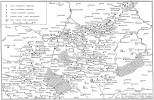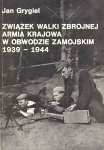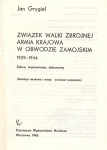Expelled from the Zamosc region during WWIIDeported for forced labour to Germany and USSR
Campaign participants -1939, Resistance and 1944/5
0274 Walenty, 0377 Lucjan, 0356
Eugenia Halina and many others
Short historical introduction
German actions –
(involved
primarily Family members living in the area of Zamosc).
1.
“Test trial” expulsions – November and December 1941 – 6
villages. (Wysokie – November 8, 1941).
2.
Peak period of expulsions: stage I – November 28, 1942 to
March 1943 – 116 villages. (Sitaniec – December 6, 1942), Stage
II – from June to August 1943 – 171 villages (with pacification operations).
3.
Around 100-110 000 Polish inhabitants were expelelled,
including 30 000 children – if racially “clean”, destined for
germanisation. Only about 800 children were recovered after the war. Most
of the people expelled were sent as slave labour in Germany or to
concentration camps, many were killed.
Soviet (USSR) actions
– (involved
primarily Family members who originated from the area, but moved away
earlier).
1.
1937-1938, “cleansing” operation – mass deportation of Poles
who still lived in former polish territories, lost at the time of the
Poland’s “Partitioning” and after WWI and from the “autonomous regions” of
“Marchlewszczyzna” and “Dzierzynszczyzna”.
2.
1939-1941, USSR repressions against Poles and Polish
citizens – after Soviet invasion of Poland on September 17, 1939:
Deportations from the “Kresy” (Borderlands), 1939-1941 – 700 000, POW’s –
240 000 (camps – Starobielsk, Ostaszkow, Kozielsk, places of murder –
Katyn, Twer, Charkow), arrested – 50 000, drafted into the Red Army – 150
000, into Strojbatallions – 100 000.
3.
1944-1946, repressions after the Soviet Army re-entered the
Polish territory and established a Communist Regime; continuation of the
1939-1941 policies and persecution of the WWII Underground Resistance
organization members.
4.
1944-1946 – first repatriation (“depatriation”) of the
polish inhabitants of the pre-WWII eastern polish territories (“Kresy”),
after their annexation and incorporation into the Soviet Union.
5.
1955-1959 – second repatriation of the Poles from the former
polish territories.
Maps depicting the territory and localities in the Zamosc region
from which the Polish population was expelled by the Germans during WWII
(Maps and commentaries were obtained courtesy of Mr. Wlodzimierz Kaluza)

[167kb]
"Zamosc region 1942-1943" - from the 8th-grade textbook by A.L. Szczesniak "History 1914-1989" - Warszawa 1999, page 255. Localities affected by the expulsions are indicated - total (solid dots) and partial - (semicircles). |

[137kb]
"German occupation of Polish territories during years 1941-1944" - from the book by C. Brzoza "Wielka historia Polski", vol.9, page 325. Dark orange coloring indicates "area in the Zamosc region affected by expulsions". | | A.L. Szczesniak comments indicate that following the lost battle at Stalingrad, and first of all as a result of firm Polish armed resistance, the Germans abandoned the realization of their earlier plans of settling the Zamosc region with ethnic Germans - thus it is not inconceivable that the original plans included much larger area than that, which is indicated on the maps. |
See below excerpts from this book describing the participation of the Wajszczuk Family members from the Zamosc area in Underground Resistance activities during the years 1939 - 1944:

book cover |

title page
ISBN 83-01-05379-8 |
page 111
(...) "Rybitwa" was in contact with Mieczyslaw Wszytko, Maria Krzeczkowska ("Marta"), Stanislaw Argasinski, Wladyslaw Lewicki.
Eugenia Halina Wajszczuk ("Galazka") was the liaison person to the director of the clandestine gymnasium and lyceum of Stanislawa Zochowska ("Antonina"). She was also in touch with Mieczyslaw Bugaj ("Bohun"), Sabina Chmura and Roman Szczur ("Urszula") (...) |
page 156
(...) The second outpost in the Mokre district was the outpost Wysokie. A conspiracy unit on the territory of this commune was first organized in the village of Sitaniec and then led by a Second Lieutenent of Reserves, a farmer Piotr Adamczuk ("Boruta"). His wife Stefania "Borutowa" (a teacher in Sitaniec, then in Lipsk - not working at school since the spring, resided in Zwierzyniec) reconstructed now from memory the membership of this group: Lucjan Majdan (son of the sacristian), Edward Blaszczak (a farmer - killed near Osuchy, buried in the cemetery at the Rotunda in Zamosc), Seweryn Blaszczak, Jan Blaszczak (a seminarian at that time), Piotr Tchorzewski, Eugeniusz Tchorzewski, Krzysztof Orczyk (a High School graduate), Piotr Ochniewski (a carpenter), Stanislaw Przybylowicz (a teacher), Jan Przybylowicz, son of Stanislaw and Maria (cought at the Hungarian border.. |
page 157
... perished on the Krakow (Cracow) Market Square in 1940), Leon Ostowicz, Jozef Niescior and his son Mieczyslaw (a high school pupil - both perished in Oswiecim (Auschwitz) in 1941, Maria Michel ("Wisla"), Lucjan Wajszczuk (a farmhand), Stanislaw Bizior (took part in the battle at Osuchy), Antoni Bizior (a N.C.O.), Piotr Michel, Reserve Officer Cadet - Mieczyslaw Michel, Ryszard Weclaw, Jan Wajland and others. Ryszard Weclaw perished in Auschwitz, his brother - captain in the 9th Infantry Regiment - Boleslaw Weclaw died during the September 1939 campaign in the village of Brudek (Zamosc district). Piotr Michel - arrested on March 8, 1941 (perished in Auschwitz on July 29, 1941). A radio station was hidden in his apartment under the floor, it was later stored at Boleslaw Truchonowicz in Zamosc. For some time, this equipment remained at Jozef Sedziak ("Iskra"), as mentioned previously. Truchonowicz, his wife Helen and daughter - were the contact site for "Robert". The radio broadcast news were printed on a duplicating machine at Piotr Michel's place. Mieczyslaw Michel, who was cought during the pacification on May 19, 1942, killed with a pitchfork the escorting German, but was shot to death by another gendarme. Maria Michel ("Wisla") was a liaison person to Wiktor Szpryngier, who was the "Wojt" (Chief Officer) of the Wysokie group of villages - parish ("Gmina") and who was helping the members of the (underground) organization.
After arrest and murder of Boleslaw Wnuk, who previously held the position of Wojt of Wysokie (denunciation by an Ukrainian from Siedliska), the Germans forced Szpryngier to assume the function of Wojt of this parish, arguing that he is of German descent and has a big influence locally. This happened in December of 1939. He assumed the position, but in spite of great pressure, did not sign the petition to become the German citizen (Volkslist). He had already some contacts with the (underground) organization, for instance with Tadeusz Paul from Udrycze, Walenty Wasko from Wolica Sitaniecka. He distributed the radio news, which were printed and duplicated at his cousin's place in Zamosc (tailor shop - under the entrance staircase to the City Hall) - Jan Szpringer (note slightly different spelling of the last name), to the Village Administrators ("Soltys") in his parish, for instance to Wajszczuk* from the village of Wysokie. He was giving aid to the needy from the communal treasury, for instance to Walenty Wasko from Wolica Sitaniecka. Soon afterwards Jan Szpringer was arrested. He perished in Auschwitz. At that time Wiktor Szpryngier gave up his job in Gmina and decided to travel to Warsaw. He was arrested at the Zamosc railroad station and brought to the post of the Polish Police (...) |
* above - refers to Walenty Wajszczuk (0274)
Information from a letter received from Janusz Wajszczuk (0296) dated September 9, 2003 concering his father Walenty (0274):
"...In response to your letter, I wish to clarify:
1. The position of village administrator (Soltys) in Wysokie until 1941 was held by my father Walenty (0274). The inhabitants of the village of Wysokie were expelled on November 8, 1941 by the Germans. My whole family was held in a transition camp in Zamosc and then in Hostynne. It should be accepted that the person mentioned in Jan Grygiel's book (see below) was my father... "
Expulsions and deportations According to the information currently available to us, the following persons or their families, belonging to the Zamosc branch of the Wajszczuk Family, were expelled by the Germans from the Zamosc region and/or deported for forced labor to Germany. Some were deported to the Soviet Union after Soviet attack on Poland on September 17, 1939.
Stanisław Wajszczuk (1094) - deported, died in Germany in 1943. Walenty Wajszczuk (0274) - expelled with his family on November 8, 1941 - later returned to the area. Jan Wajszczuk (0311) - deported with family, died in Germany in 1948. Family emigrated to the USA in 1949. Tomasz Wajszczuk (0368) - in or around 1934 moved to the Wolyn province, deported (in 1939?) to the Soviet Union, returned in 1956(?). Lucjan Wajszczuk (0377) - his property torched by the Germans in repraisal for "illegal activity", jailed in the Lublin Castle and in the Majdanek Concentration Camp, deported to Germany, emigrated to Canada. Walery Wajszczuk (0405) - expelled in 1942, deported (with family?) to Germany, returned to Poland. Stanisław Wajszczuk (0409) - deported with family in 1942, died in Germany in 1942. Kazimierz Wajszczuk (0422) - deported with family (from the Nowogrodek area) in 1940 to the Soviet Union (Kazakhstan), returned in 1946, resettled in the "Western Territories". Maria Michałkiewicz (0442) - expelled and deported with family in 1942 to Germany - returned, resettled in the "Western Territories".
Took part in the campaign of 1939, Underground Resistance, campaign of 1944/5 or Polish Army abroad: Hieronim Szewczuk (1100) - soldier in 1939, died in combat. Józef Wajszczuk (0298) - jailed, perished in Auschwitz(?). Bronisław Wajszczuk (0301) - soldier in 1939, Soviet POW, joined Gen. Anders' Army - returned to Poland. Heronim Wajszczuk (0306) - "Partisan", in forest camps. Jan Wajszczuk (0325) - soldier in 1939, member of "Underground Organization", jailed in the Lublin Castle, released, deported with family to Germany - see above. Stefan Wajszczuk (0330) - soldier in ZWZ-AK (Home Army) then in the Polish Army in liberated Poland, lost his leg in 1945, awarded the "Virtuti Militari" cross. Eugenia
Halina Wajszczuk-Skoczek (0356) - (ur.?) - liaison officer in ZWZ-AK (Home Army), "Gałązka". Lucjan Wajszczuk (0377) - "illegal activity" during occupation - see above. Halina
Eugenia Wajszczuk-Sioma (0383) - active in Underground Resistance". Edward Wajszczuk (0410) - member of "Szare Szeregi" ("Gray Ranks") - clandestine scouting organization. Kazimierz Wajszczuk (0423) - died in battle at Studzianki - see above.
Read More:
German Actions
(expulsions) during WWII:
http://en.wikipedia.org/wiki/Zamo%C5%9B%C4%87
Zamość was founded in the year
1580 by the
Chancellor and
Hetman
(head of the army of the
Polish-Lithuanian Commonwealth)
Jan Zamoyski, on the trade route linking western and northern
Europe
with the
Black
Sea. (…)The Old City quarter of Zamość has been placed on the
UNESCO
list of
World Heritage Sites.
In
1942, Zamość
County, due to its fertile black soil, was chosen for further German
colonisation in the
General Government as part of
Generalplan Ost. The city itself was to be renamed "Himmlerstadt" (Himmler
City) and the German occupiers had planned the relocation of at least
60,000 ethnic Germans in the area before the end of
1943. Before
that, a "test trial"
expulsion was performed in November 1941, and the whole operation
ended in a
pacification operation, combined with expulsions in June/July 1943
which was code named Wehrwolf Action I
and II. Around 110,000 people from 297 villages were expelled. Around
30,000 victims were children who, if racially "clean" (ie. had physical
characteristics deemed "Germanic") were planned for germanisation in
German families in the
Third Reich. Most of the people expelled were sent as slave labour in
Germany or to concentration camps.
Local people resisted the action
with great determination; they escaped into forests, organised self-defence,
helped people who were expelled, and bribed kidnapped children out of
German hands. Until the middle of 1943, the Germans managed to settle
8,000 colonists, the number increased by a couple of thousand more in
1944. This settlement was met with fierce armed resistance by
Polish Underground forces.
Expulsions
(and history of persecutions) by the Soviets
(http://en.wikipedia.org/wiki/Repatriation_of_Poles_%281944-1946%29)
The history of Polish settlement in Ukrainian territories dates
back to 1030–31. Colonization of Ukraine by large numbers of Poles became
more common after the
Union of Lublin in 1569 when most of the Ukrainian lands were
incorporated into the
Polish-Lithuanian Commonwealth. (…) In 1914 there were 1,640,000 Poles
in that region. In 1917 the Polish population of
Kiev was
42,800. (…) In the aftermath of the
Polish-Soviet war Ukraine failed to gain independence (despite the
Polish-Ukrainian alliance) and in the
Treaty of Riga in 1921 the disputed territories were split between the
Second Polish Republic and the
Ukrainian SSR (after 1923 a part of the
Soviet Union). (…) In Poland, a large number of Polish settlers moved
to Ukraine (see
osadnik).
(…)
Polish minority in modern Belarusian territory (http://en.wikipedia.org/wiki/Polish_minority_in_Belarus)
stated to form during the times of
Polish-Lithuanian Commonwealth, due to voluntary
Polonization and settlement. Polish influence, weakened by
partitions of Poland, was restored over the
West Belarus in the
interwar period, but was again weakened after the
Soviet invasion of Poland, when West Belarus was incorporated into the
Belarusian SSR. At that time and over subsequent years, many Poles,
who inhabited that region were either killed or deported (first east -
when during the Second World War the Soviet forcibly resettled large
numbers of Belarusian Poles to Russia, Kazakhstan and Uzbekistan; later
west, to shifted
Poland;
see
Repatriation of Poles (1944-1946)).
In
the USSR, the Soviet government from the mid 1920s treated the Polish
population (see
Polish minority in USSR) as disloyal (…). Mass deportations started in
the autumn of 1935 in order to remove Poles from the border regions (…and
they) were deported to
Kazakhstan. (…)
Polish operation
of the NKVD
- (http://en.wikipedia.org/wiki/Polish_operation_of_the_NKVD)
The operation occurred approximately from
August
25, 1937
to
November 15,
1938. According to the archives of the NKVD, 111,091
Poles were
sentenced to death and 28,744 were sentenced to
labor
camps, 139,835 in total.
After the signing of the secret
Molotov-Ribbentrop pact in 1939 between Nazi Germany and the Soviet
Union,
Germany invaded Western Poland. Two weeks later the
Soviet Union also invaded eastern Poland. (…) (http://en.wikipedia.org/wiki/Polish_minority_in_USSR)
(…) another 5.2-6.5 million Poles (from the total population of about 13,5
million of these territories) were added
(to the number of the deportees),
with further large-scale deportations to Kazakhstan and other areas. (…)
The following is case of direct
executions of Poles during the 1939-1941 occupation:
Katyn massacre 15,000,
executions of prisoners after the German invasion 1941.
After World War II most Poles from
Kresy (http://en.wikipedia.org/wiki/Kresy)
were expelled into Poland, but officially 1.3 million stayed in the USSR.
Some of them were motivated by the traditional Polish belief that one day
they would become again lawful owners of the land they lived on. Some of
them were kept forcefully in. There are reasons to believe that those
expelled were happier than those who stayed.
see also:
|